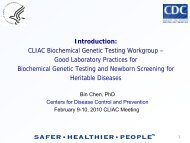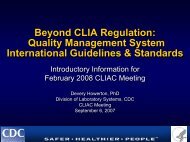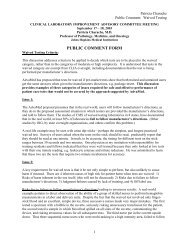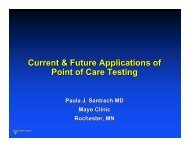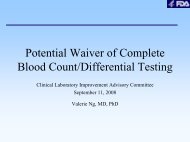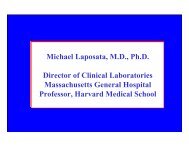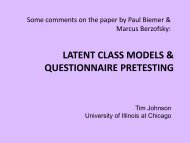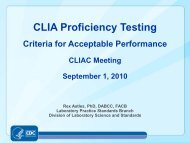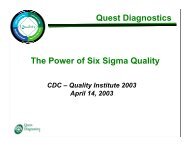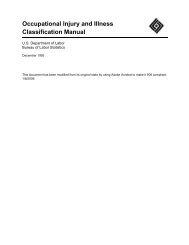CLIA-waived Rapid HIV Testing in the Public - Centers for Disease ...
CLIA-waived Rapid HIV Testing in the Public - Centers for Disease ...
CLIA-waived Rapid HIV Testing in the Public - Centers for Disease ...
- No tags were found...
Create successful ePaper yourself
Turn your PDF publications into a flip-book with our unique Google optimized e-Paper software.
<strong>CLIA</strong>-<strong>waived</strong> <strong>Rapid</strong> <strong>HIV</strong> <strong>Test<strong>in</strong>g</strong> <strong>in</strong> <strong>the</strong><strong>Public</strong> Health SectorDuncan MacKellarTeam Leader, Diagnostic Applications, BCSBDivision of <strong>HIV</strong>/AIDS Prevention, Surveillance and Epidemiology<strong>Centers</strong> For <strong>Disease</strong> Control and PreventionThe f<strong>in</strong>d<strong>in</strong>gs and conclusions <strong>in</strong> this presentation are those of <strong>the</strong>authors and do not necessarily represent <strong>the</strong> views of <strong>the</strong><strong>Centers</strong> <strong>for</strong> <strong>Disease</strong> Control and Prevention
Need <strong>for</strong> Expand<strong>in</strong>g <strong>HIV</strong> <strong>Test<strong>in</strong>g</strong>‣ 252,000 – 312,000 persons with undiagnosed <strong>HIV</strong> <strong>in</strong>fection‣ ~ 40,000 new <strong>HIV</strong> <strong>in</strong>fections per year‣ ~ 50% of all new sexually transmitted <strong>HIV</strong> <strong>in</strong>fections areattributed to persons unaware of <strong>the</strong>ir <strong>in</strong>fection‣ ~ 33% of <strong>HIV</strong>-<strong>in</strong>fected persons are diagnosed late <strong>in</strong> <strong>the</strong>course of <strong>the</strong>ir illness‣ ARV <strong>the</strong>rapy is of proven benefit cl<strong>in</strong>ically and <strong>in</strong> reduc<strong>in</strong>gper<strong>in</strong>atal <strong>HIV</strong> transmission‣ CDC has supported <strong>the</strong> use of <strong>CLIA</strong>-<strong>waived</strong> rapid tests s<strong>in</strong>ce2003 to expand test<strong>in</strong>g to reduce undiagnosed <strong>in</strong>fections, latediagnoses, and per<strong>in</strong>atal transmission
Presentation Objectives1. Review <strong>the</strong> per<strong>for</strong>mance of <strong>CLIA</strong>-<strong>waived</strong> rapid <strong>HIV</strong> tests2. Characterize quality assurance practices and outcomes3. Describe magnitude of <strong>CLIA</strong>-<strong>waived</strong> rapid <strong>HIV</strong> test<strong>in</strong>g
OraQuick Advance <strong>HIV</strong>-1/2FDA-approved claims <strong>for</strong>:Sensitivity (<strong>HIV</strong>-1):Whole blood 99.6% (98.5 - 99.9)Oral fluid 99.3% (98.4 - 99.7)Specificity (<strong>HIV</strong>-1):Whole blood 100% (99.7-100)Oral Fluid 99.8% (99.6 – 99.9)<strong>CLIA</strong>-<strong>waived</strong>:Whole blood: Jan 2003Oral fluid: Jul 2004
Uni-Gold RecombigenFDA-approved claims <strong>for</strong>:Sensitivity:Whole blood 100% (99.5 - 100)Plasma/serum 100% (99.5 -100)Specificity:Whole blood 99.7% (99.0-100)Plasma/serum 99.8% (99.3 -100)<strong>CLIA</strong>-<strong>waived</strong>:Whole blood: Nov 2004
Clearview <strong>HIV</strong>-1/2 Stat-PakFDA-approved claims <strong>for</strong>:Sensitivity (<strong>HIV</strong>-1):Whole blood 99.7% (98.9-100)Plasma/serum 99.7% (98.9-100)Specificity (<strong>HIV</strong>-1):Whole blood 99.9% (99.6-100)Plasma/serum 99.9% (99.6-100)<strong>CLIA</strong>-<strong>waived</strong>:Whole blood: Nov 2006
Data Sources1. Four CDC-sponsored studies, 2000-20052. Post-market<strong>in</strong>g surveillance, 2004-20053. Selected health departments, 2005-2006
Four CDC-sponsored Studies*Objectives & Methods‣ Evaluate per<strong>for</strong>mance of OraQuick <strong>in</strong> sett<strong>in</strong>gs of likely use‣ Per<strong>for</strong>mance compared with conventional EIA/WB algorithm‣ Subjects <strong>in</strong>cluded pregnant women at 18 hospitals, and HRH,IDU, and MSM at 41 community outreach sites, 3 <strong>HIV</strong> testssites, and 2 STD cl<strong>in</strong>ics‣ Tests adm<strong>in</strong>istered by laboratorians, physicians, nurses,midwives, and <strong>HIV</strong> counselors‣ Studies implemented between April 2000 and January 2005*Delaney KP, et al. Per<strong>for</strong>mance of an oral fluid rapid <strong>HIV</strong>-1/2 test:experience from four CDC studies. AIDS 2006;20:1655-1660.
Sensitivity Results*<strong>Rapid</strong> Test(Specimen)ReferencePositiveFalseNegativeSensitivityOraQuick327199.7%(Whole blood)OraQuick327399.1%(Oral fluid)*Delaney KP, et al. Per<strong>for</strong>mance of an oral fluid rapid <strong>HIV</strong>-1/2 test:experience from four CDC studies. AIDS 2006;20:1655-1660.
Specificity Results*<strong>Rapid</strong> Test(Specimen)ReferenceNegativeFalsePositiveSpecificityOraQuick12,0101299.9%(Whole blood)OraQuick12,0105499.6%(Oral fluid)ConventionalEIA12,0103599.7%*Delaney KP, et al. Per<strong>for</strong>mance of an oral fluid rapid <strong>HIV</strong>-1/2 test:experience from four CDC studies. AIDS 2006;20:1655-1660.
False Positive OraQuick Oral Fluid Results,University of M<strong>in</strong>nesota**Jafa K, et al. Investigation of false positive results with an oralfluid rapid <strong>HIV</strong>-1/2 antibody test. PLos one 2007;1:1-6.
Observed SpecificityUniversity of M<strong>in</strong>nesota*Time PeriodReferenceNegativeFalsePositiveSpecificityJul 2002 – Apr 20042,017799.7%Apr 2004 – Aug 20043881695.9%Jul 2002 – Aug 200424052399.0%*Jafa K, et al. Investigation of false positive results with an oralfluid rapid <strong>HIV</strong>-1/2 antibody test. PLos one 2007;1:1-6.
Investigation & Incidence Study*Investigation‣ 16 false-positive results from unexpired devices from 6 lots‣ All lots produced and shipped with<strong>in</strong> specifications‣ Each lot used at o<strong>the</strong>r sites without excess false-positive results‣ All temperatures recorded <strong>in</strong> device storage and test logs were with<strong>in</strong>manufacturer’s specifications‣ Devices had very fa<strong>in</strong>t, gray, or shadowy test l<strong>in</strong>es‣ Four operators <strong>in</strong>terpreted <strong>the</strong> results‣ Operator practices observed <strong>in</strong> accordance with PI‣ Only significant factor: age > 37 yearsIncidence study, Feb-May 2005, 9 cities <strong>in</strong> 3 states*‣ 2,268 tests, no false-positive results (specificity 100%)‣ Case-control study could not proceed*Jafa K, et al. Investigation of false positive results with an oralfluid rapid <strong>HIV</strong>-1/2 antibody test. PLos one 2007;1:1-6.
Data Sources1. Four CDC-sponsored studies, 2000-20052. Post-market<strong>in</strong>g surveillance, 2004-20053. Selected health departments, 2005-2006
Post-market<strong>in</strong>g Surveillance,2004-2005*Objectives‣ Evaluate use and per<strong>for</strong>mance of OraQuick‣ Characterize quality assurance practices and outcomesMethods‣ 17 participat<strong>in</strong>g health departments, 368 sites, Aug 2004 – June 2005‣ Predom<strong>in</strong>ately CTS, STD, outreach, and correctional sett<strong>in</strong>gs‣ Tests adm<strong>in</strong>istered by counselors and lab techs‣ Prelim<strong>in</strong>ary positive results subject to WB/IFA confirmation, clients withdiscordant test results were counseled to re-test.‣ Active surveillance of all discordant test results‣ False positive results based on <strong>in</strong>itial or repeat WB/IFA confirmation*Wesolowski LG, et al. Post-market<strong>in</strong>g surveillance of OraQuick wholeblood and oral fluid rapid <strong>HIV</strong> test<strong>in</strong>g. AIDS 2006;20:1661-1666.
Project Areas*ChicagoSanFranciscoNew YorkCity*Wesolowski LG, et al. Post-market<strong>in</strong>g surveillance of OraQuick wholeblood and oral fluid rapid <strong>HIV</strong> test<strong>in</strong>g. AIDS 2006;20:1661-1666.
Post-market<strong>in</strong>g Surveillance,2004-2005*Test andspecimen typeNo. ofTests<strong>HIV</strong> +Median %(range)EstimatedSpecificityMedian % (range)PPVMedian %(range)OQ wholeblood135,7240.8 (0.1-2.6)99.98 (99.73-100)99.2 (66.7-100)OQ oral fluid26,0661.0 (0.0-4.0)99.89 (99.44-100)90.0 (50.0-100)Discordant test results‣ Of 124 <strong>in</strong>itially discordant test results: 17 (14%) true positiveReceipt of test results‣ 94% of non-reactive rapid test results provided‣ 95% of reactive rapid test results provided 75% of confirmed results provided*Wesolowski LG, et al. Post-market<strong>in</strong>g surveillance of OraQuick wholeblood and oral fluid rapid <strong>HIV</strong> test<strong>in</strong>g. AIDS 2006;20:1661-1666.
Excess False-positive OF Test Results, 1San Francisco Test Site**Wesolowski LG, et al. Post-market<strong>in</strong>g surveillance of OraQuickwhole blood and oral fluid rapid <strong>HIV</strong> test<strong>in</strong>g. AIDS 2006;20:1661-1666.
Investigation*F<strong>in</strong>d<strong>in</strong>gs‣ 33 false-positive results from unexpired devices from 4 lots‣ Each lot used at 11 o<strong>the</strong>r SF sites without excess false-positive results‣ 29 (88%) devices had very fa<strong>in</strong>t, gray, or shadowy test l<strong>in</strong>es‣ Seven operators <strong>in</strong>terpreted <strong>the</strong> results confirmed by >1 o<strong>the</strong>r operators‣ Operator practices observed <strong>in</strong> accordance with PI with exception of OFcollection (some recommended swabb<strong>in</strong>g gum l<strong>in</strong>e > 1 time)‣ Operators re-tra<strong>in</strong>ed <strong>in</strong> October; 13 (39%) false positive resultsoccurred after re-tra<strong>in</strong><strong>in</strong>g‣ Of 163 external controls, two were <strong>in</strong>valid; 161 yielded concordantresults‣ All temperatures recorded <strong>in</strong> device storage and test logs were with<strong>in</strong>manufacturer’s specifications*Wesolowski LG, et al. Post-market<strong>in</strong>g surveillance of OraQuick wholeblood and oral fluid rapid <strong>HIV</strong> test<strong>in</strong>g. AIDS 2006;20:1661-1666.
Data Sources1. Four CDC-sponsored studies, 2000-20052. Post-market<strong>in</strong>g surveillance, 2004-20053. Selected health departments, 2005-2006
New York State AnonymousCounsel<strong>in</strong>g & <strong>Test<strong>in</strong>g</strong> Program 2005*<strong>Rapid</strong> Test(specimen type)ReferenceNegativeFalsePositiveSpecificityOraQuick (whole blood)13,473799.9%OraQuick (oral fluid)10,0772999.7%*San Antonio-Gaddy M. CDC Presentation, Jan 10, 2007.
New York State AnonymousCounsel<strong>in</strong>g & <strong>Test<strong>in</strong>g</strong> Program 2006*<strong>Rapid</strong> Test(specimen type)ReferenceNegativeFalsePositiveSpecificityOraQuick (whole blood)3,7250100%OraQuick (oral fluid)1,838599.7%Uni-Gold (whole blood)16,5401799.9%*San Antonio-Gaddy M. CDC Presentation, Jan 10, 2007.
Presentation Objectives1. Review <strong>the</strong> per<strong>for</strong>mance of <strong>CLIA</strong>-<strong>waived</strong> rapid <strong>HIV</strong> tests2. Characterize quality assurance practices and outcomes3. Describe magnitude of <strong>CLIA</strong>-<strong>waived</strong> rapid <strong>HIV</strong> test<strong>in</strong>g
Post-market<strong>in</strong>g Surveillance,2004-2005*Methods (Practices)‣ Adm<strong>in</strong>istered survey to rapid test program managers: Tra<strong>in</strong><strong>in</strong>g requirements Quality assurance monitor<strong>in</strong>g Operator competency assessment‣ Limitation: all assessments were made at <strong>the</strong> program level
Post-market<strong>in</strong>g Surveillance,2004-2005*Methods (Practices)‣ Adm<strong>in</strong>istered survey to rapid test program managers: Tra<strong>in</strong><strong>in</strong>g requirements Quality assurance monitor<strong>in</strong>g Operator competency assessment‣ Limitation: all assessments were made at <strong>the</strong> program levelMethods (Outcomes)‣ From Jan 2005 – Jun 2005, provided monthly <strong>for</strong>ms and conductedactive surveillance of <strong>in</strong>valid tests, external quality control runs, andtemperature violations
Quality Assurance Practices*Required Tra<strong>in</strong><strong>in</strong>g: Median (range)‣ 6 (3-16) hrs <strong>for</strong> operat<strong>in</strong>g rapid tests‣ 6 (1-40) hrs <strong>for</strong> counsel<strong>in</strong>g rapid-test clients‣ 40 (20-80) total hrs <strong>for</strong> <strong>HIV</strong> test and counsel<strong>in</strong>g “certification”Tra<strong>in</strong><strong>in</strong>g Methods‣ 4 (24%) <strong>in</strong>ternet or video‣ 10 (59%) one-on-one tra<strong>in</strong><strong>in</strong>g at rapid test site‣ 15 (88%) state, city, or county developed tra<strong>in</strong><strong>in</strong>g course‣ 2 (12%) CDC rapid test tra<strong>in</strong><strong>in</strong>g course‣ 6 (35%) o<strong>the</strong>r‣ 17 (100%) assessed competency <strong>in</strong> test per<strong>for</strong>mance and<strong>in</strong>terpretation of all three types of results
Quality Assurance PracticesPost-tra<strong>in</strong><strong>in</strong>g Monitor<strong>in</strong>g‣ 15 (88%) visited all test sites dur<strong>in</strong>g PMS-2 to establish/evaluate QA‣ 10 (59%) conducted onsite QA monitor<strong>in</strong>g at least every six months*Question: Which of <strong>the</strong> follow<strong>in</strong>g activities were per<strong>for</strong>med byHD staff <strong>for</strong> all sites dur<strong>in</strong>g PMS-2? These QA activities mayhave been conducted on or off site.
Quality Assurance PracticesPost-tra<strong>in</strong><strong>in</strong>g Monitor<strong>in</strong>g‣ 15 (88%) visited all test sites dur<strong>in</strong>g PMS-2 to establish/evaluate QA‣ 10 (59%) conducted onsite QA monitor<strong>in</strong>g at least every six months‣ 16 (94%) reviewed external QC test procedures*‣ 16 (94%) exam<strong>in</strong>ed test logs*‣ 12 (71%) exam<strong>in</strong>ed temperature logs*‣ 8 (47%) observed operators collect specimens*‣ 9 (53%) observed operators <strong>in</strong>terpret results*‣ 10 (59%) observed how test results were expla<strong>in</strong>ed to clients*‣ 15 (88%) reviewed procedures to address <strong>in</strong>valid and discordant testresults**Question: Which of <strong>the</strong> follow<strong>in</strong>g activities were per<strong>for</strong>med byHD staff <strong>for</strong> all sites dur<strong>in</strong>g PMS-2? These QA activities mayhave been conducted on or off site.
Quality Assurance Practices*Internal Competency Assessment‣ 10 (59%) conducted at least annual assessments after tra<strong>in</strong><strong>in</strong>g 4 used placards with OraQuick test results 4 used bl<strong>in</strong>ded external control specimens 2 used samples sent from health department labExternal Competency Assessment‣ 13 (76%) enrolled <strong>in</strong> external assessment program 10 (59%) MPEP 3 (18%) CAP*Survey of rapid test coord<strong>in</strong>ators from 17 state and local healthdepartments, post-market<strong>in</strong>g surveillance, 2004-2005.
Quality Assurance OutcomesJan-Jun 2005: 86,749 <strong>Rapid</strong> Tests*‣ 20 (0.02%) <strong>in</strong>valid test results (no control l<strong>in</strong>e or red background <strong>in</strong>results w<strong>in</strong>dow)‣ 9,217 external control runs ~ 10 persons tested/external qualitycontrol run (5/17 HDs recommended runn<strong>in</strong>g daily controls)‣ 4 external controls reported as “<strong>in</strong>valid” (3 health departments)‣ 31 (0.06%) site-days where > 1clients tested when temperaturewas out of spec (3 health departments)‣ 161 (0.32%) site-days where tests stored when temperature wasout of spec (5 health departments)*308 report<strong>in</strong>g sites; represent<strong>in</strong>g ~ 49,896 site-days (308*162)dur<strong>in</strong>g 6-month report<strong>in</strong>g period
Presentation Objectives1. Review <strong>the</strong> per<strong>for</strong>mance of <strong>CLIA</strong>-<strong>waived</strong> rapid <strong>HIV</strong> tests2. Characterize quality assurance practices and outcomes3. Describe magnitude of <strong>CLIA</strong>-<strong>waived</strong> rapid <strong>HIV</strong> test<strong>in</strong>g
Data Sources1. <strong>Rapid</strong> Test Distribution Program, 2003-20062. <strong>Rapid</strong> Test Assessment Report, NASTAD, 2005-20063. Selected Health Departments, 2005-2006
<strong>Rapid</strong> <strong>HIV</strong> Test Distribution ProgramObjectives & Methods‣ Implemented to help scale up rapid test programs <strong>in</strong> support ofAdvanc<strong>in</strong>g <strong>HIV</strong> Prevention <strong>in</strong>itiative‣ 2003-2005: distributed tests to state and local health departments,medical centers, and CBOs Quarterly reports submitted on use of devices‣ 2006-2007: distributed tests to state and local health departments <strong>in</strong>proportion to AIDS morbidity Counsel<strong>in</strong>g and test<strong>in</strong>g data sets will be submitted
RTDP 2003-2005‣ 790,310 devices distributed‣ 121 state/local health depts‣ 101 medical centers/CBOs‣ 8 correctional facilities‣ 230 organizations submittedreports (606,951 devices)‣ 372,960 devices used‣ 4,650 (1.2%) prelim<strong>in</strong>arypositive test results confirmed<strong>HIV</strong> positive‣ 79% of confirmed results givento clients
<strong>Rapid</strong> Test Distribution ProgramDevices Distributed‣ 37 States, DC, Puerto Ricoand US Virg<strong>in</strong> Islands‣ Primarily to moderate andhigh morbidity areas.‣ RTDP July 2006 – June 2007: 211,800 OraQuickdevices 59% distributed throughDec 2006
Data Sources1. <strong>Rapid</strong> Test Distribution Program, 2003-20062. <strong>Rapid</strong> Test Assessment Report, NASTAD, 2005-20063. Selected Health Departments, 2005-2006
<strong>Rapid</strong> <strong>HIV</strong> <strong>Test<strong>in</strong>g</strong> Assessment*Objectives & Methods‣ Evaluate procurement and use of rapid tests‣ Questionnaires sent to 65 directly funded health departmentAIDS program directors and prevention managers‣ Survey completed August 2006‣ 43 (66%) respondents 39 state health departments 3 city health departments 1 territorial health department*NASTAD <strong>Rapid</strong> <strong>HIV</strong> <strong>Test<strong>in</strong>g</strong> Assessment Report: www.nastad.org
Support <strong>Rapid</strong> <strong>HIV</strong> Test Programs*Participat<strong>in</strong>g Health Departments (n=43)‣ 35 (81%) supported a rapid test<strong>in</strong>g program‣ 8 did not currently support a program 6 (75%) <strong>in</strong>sufficient resources 2 (25%) statutory or regulatory barriers 4 (50%) will implement program <strong>in</strong> next 12 months‣ 39 (91%) will support program <strong>in</strong> next 12 months 39 (100%) will cont<strong>in</strong>ue to use conventional test<strong>in</strong>g‣ Sett<strong>in</strong>gs Outreach (81%), <strong>HIV</strong> test sites (72%), CBOs (70%) Labor & delivery (26%), Hospital EDs (19%)*NASTAD <strong>Rapid</strong> <strong>HIV</strong> <strong>Test<strong>in</strong>g</strong> Assessment Report: www.nastad.org
Projected Purchases, 2006*Quantity of TestsOraQuickN (%)Uni-GoldN (%)TotalN
Volume of <strong>Rapid</strong> and Conventional<strong>Test<strong>in</strong>g</strong>*Year<strong>Rapid</strong> TestsN (%)Conventional TestsN (%)Total TestsN2005 445,063 (25%) 1,358,644 (75%) 1,803,7072006 1 613,850 (33%) 1,236,382 (67%) 1,850,2321Pojected‣ Projected 37.9% <strong>in</strong>crease <strong>in</strong> rapid test<strong>in</strong>g‣ Projected 9.0% decrease <strong>in</strong> conventional test<strong>in</strong>g‣ Projected 2.6% <strong>in</strong>crease <strong>in</strong> total test<strong>in</strong>g*Reported by 39 health departments <strong>in</strong>tend<strong>in</strong>g to implement rapidtest<strong>in</strong>g <strong>in</strong> <strong>the</strong> next 12 months. NASTAD <strong>Rapid</strong> <strong>HIV</strong> <strong>Test<strong>in</strong>g</strong>Assessment Report: www.nastad.org
Data Sources1. <strong>Rapid</strong> Test Distribution Program, 2003-20062. <strong>Rapid</strong> Test Assessment Report, NASTAD, 2005-20063. Selected Health Departments, 2005-2006
NYSDOH ACT ProgramNumber of Tests, by Year and Test Type*Year<strong>Rapid</strong>OraQuick<strong>Rapid</strong>Uni-GoldConventionalOral FluidConventionalSerumTotalTests20036,581010,2612,43419,471200420,297020,9902005 23,657 014448 23,9442006 1 3,460 16,54000 20,00012006 Data is <strong>in</strong>complete‣ NYSDOH policy is <strong>for</strong> counselors to offer all test<strong>in</strong>g options to all clients. Conventionaltest<strong>in</strong>g was available <strong>in</strong> 2006.462126*San Antonio-Gaddy M. CDC Presentation, Jan 10, 2007.
Florida Department of HealthNumber of Tests, by Year and Test Type*Year<strong>Rapid</strong>OraQuick<strong>Rapid</strong> Uni-GoldConventionalOral FluidConventionalSerumTotalTests20033,790078,378219,519301,6872004 23,926 063,293 208,383 295,6022005 34,780 054,745 200,020 289,5452006 1 47,000 049,460 192,668 289,1281Pojected‣ Projected 37% decrease <strong>in</strong> conventional oral fluid test<strong>in</strong>g 2003 through 2006‣ Projected 12% decrease <strong>in</strong> conventional serum test<strong>in</strong>g, 2003 through 2006*Marlene LaLota, Florida Department of Health, personalcommunication, 02/08/2007.
Conclusions<strong>CLIA</strong>-<strong>waived</strong> <strong>Rapid</strong> <strong>HIV</strong> Tests‣ Provided by most health departments; use has <strong>in</strong>creasedremarkably‣ Stored and used <strong>in</strong> accordance with <strong>the</strong> manufacturer’sguidel<strong>in</strong>es, <strong>in</strong>clud<strong>in</strong>g use on external quality controls‣ Accurate, safe, and simple to use‣ Enabled nearly all clients to receive <strong>the</strong>ir results‣ Helped to expand test<strong>in</strong>g, enabl<strong>in</strong>g <strong>HIV</strong> diagnoses of personswho might not have had <strong>the</strong>ir <strong>in</strong>fections diagnosed o<strong>the</strong>rwise
Conclusions<strong>CLIA</strong>-<strong>waived</strong> <strong>Rapid</strong> <strong>HIV</strong> Tests‣ Despite high specificity, positive predictive value can be low <strong>in</strong> somesett<strong>in</strong>gs‣ Clusters of excess false-positive test results have occurred and maycont<strong>in</strong>ue to occur‣ Many persons with prelim<strong>in</strong>ary positive test results do not return to <strong>the</strong>cl<strong>in</strong>ic to receive <strong>the</strong>ir confirmed results‣ Need to evaluate <strong>the</strong> feasibility and per<strong>for</strong>mance of a POC rapid testalgorithm to improve accuracy of results and l<strong>in</strong>kage to care
Research Needs<strong>Rapid</strong> Test Algorithm Study‣ Collaborators: Departments of Health, San Francisco and Los Angeles‣ Status: Protocol under development‣ Expected start date: Spr<strong>in</strong>g, 2007‣ Sites: multiple rapid test sites <strong>in</strong> SF and LA‣ Methods:‣ Intervention sites: screen with OraQuick on oral fluid, if reactive,repeat <strong>in</strong> series with Uni-Gold and Stat-Pak‣ All clients with reactive OQ results undergo conventional WB/IFAconfirmation‣ All clients with discordant WB/IFA results are followed‣ Evaluate % who use health-care from <strong>in</strong>tervention and control sites
Questions



